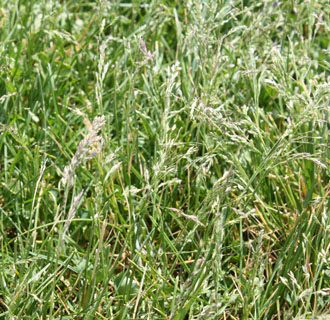A Decline in Spring Mowing Quality – What’s Going On?
As Mother Nature bounces back and forth between cool and warm-temperatures during mid- late spring there are often lots of questions asked by homeowners and professional lawn care managers alike regarding ‘I mowed the turf and it looks worse than before I cut it!’. What is most often the case in this decline in spring mowing quality is the formation of seedheads in our cool-season grasses in Virginia. Tall fescue, perennial ryegrass, Kentucky bluegrass and the fine-leaf fescues are all producing flowers and seed during this time of year in response to temperature, day length, and moisture. Seedhead production will flourish for a few weeks during this period and will then reduce greatly as warmer weather arrives.

Why does the appearance look so bad? There are two factors – 1) seedhead stalks are designed for support, therefore, they contain a lot of really tough secondary cell wall material that is much more difficult to cut when compared to succulent leaf tissue. And along this line, reason 2 is) the poor quality of cut from dull mower blades is even further exaggerated as the dull blade twists and tears the seedhead stalk away from the plant. Clipping grass with a dull mower usually results in turf that initially has a ‘whitish’ cast (from the shredded leaf and seedhead tips) that ultimately becomes a ‘brown or tan’ cast as the damaged tissues slowly senesce and die. So, one way to immediately improve quality for most is to simply sharpen the blades. How often should one sharpen the blades? On average, most homeowners in Virginia should plan on sharpening their blades at least 3 times during the growing season; professional mowing companies will likely sharpen their blades every day or so, and if you are paying for someone to mow your grass and it is obviously being cut with a dull blade, I’d be sure to mention it to them. Keeping the blades sharp and your mower in top operating condition will not only improve the health of your lawn but it will also improve fuel use efficiency and increase the life of your mower.
Finally, begin thinking about your strategy for summer mowing of cool-season grasses. Slowly but surely raise the mowing heights on cool-season grasses before the extreme environmental stresses of summer arrive. For most, it is as simple as raising the cutting deck to its highest setting. This approach promotes the deepest root system possible before the stresses of summer arrive.
Expect spring mowing quality to rebound after the flush of cool-season seedheads is complete. For detailed tips on how to optimize mowing quality, look for an archived podcast that features an audio/visual extension publication called ‘Mow Like a Pro’ on this ‘Turf and Garden Tips’ website.


